Contents
- 1. Manual 1
- 2. Manual 2
Manual 2

-36-
Desktop Interface Jump Page
Remember! When finished using the Web applications, always
click Sign Out to exit the Web site securely.
Using the Applications
myFaves
Assign up to five phone numbers to be part of your “myFaves”
service plan. When you call a myFaves phone number, you are
not charged for minutes! Contact T-Mobile to sign up for the
plan.
Add a Contact to myFaves
Create a new myFaves contact, or assign a phone number
already in your Address Book to your myFaves plan:
1 Press JUMP to go to the Jump screen. If not already
selected, scroll to highlight myFaves, then press the trackball.

-37-
2 To add a number already in your Address Book, press MENU
+ @. Roll the trackball to highlight a contact and phone
number, then press the trackball to assign the contact to
myFaves.
3 To add a new contact, press MENU + N. On the dialog box
that opens, complete the Nickname and Phone number fields.
Type a 7- or 10-digit number. You don’t need to add hyphens
or spaces in the number.
4 Confirm your decision to add the contact to myFaves by selecting
OK .
5 Your new contact will appear in the myFaves ring of contacts;
when the “pending” notice disappears, you can call or send
messages to this contact.
Communicate with a myFaves Contact
1 Press JUMP to go to the Jump screen. If not already
selected, scroll to highlight myFaves, then press the trackball.
2 Roll the trackball to highlight the myFaves contact you want to
call, then press SEND CALL . To send a text message, press
MENU and select Text.
3 If you have stored an email address or IM screen name for
the highlighted contact in the Address Book, you can open a
communication with that person quickly by pressing MENU
and selecting Email or IM.
4 To view a contact’s details (including Web site, address,
alternate phone numbers, and so on), highlight the contact,
then press the trackball. The Contact Details screen opens.
Select the Edit button to add or change the information.
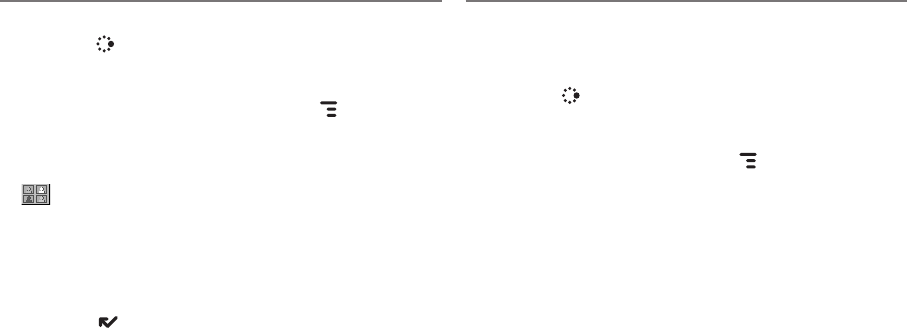
-38-
Assign an Icon to a myFaves Contact
1 Press JUMP to go to the Jump screen. If not already
selected, scroll to highlight myFaves, then press the trackball.
2 Roll the trackball to highlight the myFaves contact to whom
you want to assign an icon, then press MENU and select
Change Icon. The icon selector opens.
3 Select one of the folders to view the icons within that folder.
To assign one of your photos, open the Select from Photos
folder.
4 Select an icon or photo with the trackball. If you select a
photo from your Photo Album, you will be able to crop the
photo to the portion you want represented in the icon: roll the
trackball to move the cropper; use the D-Pad to size it.
5 The icon will appear in the Edit myFaves Contact dialog box.
Press DONE to complete the assignment.
Replace a myFaves Phone Number
Refer to the myFaves plan for how often you can replace a given
number.
1 Press JUMP to go to the Jump screen. If not already
selected, scroll to highlight myFaves, then press the trackball.
2 Roll the trackball to highlight the myFaves contact/number
you want to replace, then press MENU and select either
Replace with Another Number (using the same contact) or
Replace with Another Contact.
3 If you select Replace with Another Contact, select to add
a New myFaves Contact or Add from Address Book. (Read
more in “Add a Contact to myFaves” on page 36.)
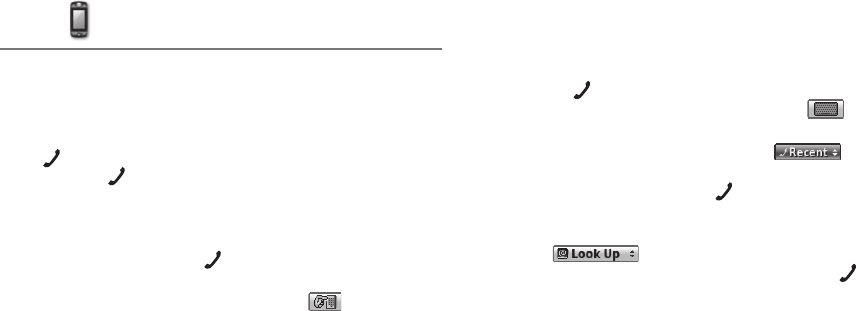
-39-
Phone
Make a Phone Call
1 You can make a call using any of these dialing methods:
n To dial using your list of speed dials and recently-dialed
numbers: From the Jump or Phone screen, press SEND CALL
. Highlight the number, then place the call by pressing
SEND CALL again.
n To dial with numbers: From the Jump screen or Phone
screen, open the display and type your number using the
embedded keyboard dial pad, or use the numbers on the
top row. Press SEND CALL to place the call.
n To dial using letters (such as 1-800-LETTERS): First open
the on-screen dial pad by selecting the button on
the Phone screen. Now you can use the keyboard to type
letters; use the on-screen dial pad or the number row to
type numbers (in this mode you can’t use the embedded
keyboard dial pad to type numbers). When ready, press
SEND CALL to place the call. To switch back to using the
embedded dial pad to type numbers, select .
n To dial using a list of recently-dialed numbers: From
the Phone screen, highlight then selec
t . If the
number you want to call is on the list, highlight it with the
trackball, then press SEND CALL .
n To dial by finding a contact and phone number from your
Address Book: From the Phone screen, highlight then
select . Start typing a name to narrow your
search. Highlight a number, then press SEND CALL to
place the call.

-40-
2 To end your call, select the on-screen button , or press
END CALL .
Use Bluetooth Hands-Free Headset or Car Kit
You can use a Bluetooth device to make or receive phone calls.
To pair and set your headset or hands-free for use with the
phone, read “Bluetooth Hands-Free Headset or Car Kit” on page
10.
Answer a Phone Call
When your device signals an incoming phone call, the display
will show the name of the caller and the icon or photo associated
with that caller in your Address Book (see “Add a Contact to the
Address Book” on page 53).
1 Press the trackball to select the Answer button or press SEND
CALL . Your call connects.
2 To hang up, select or press END CALL .
If you receive another call while you’re on the phone (call
waiting), a dialog box will appear, giving you the call details
and options for handling the incoming call: select either
Switch Calls or Ignore.
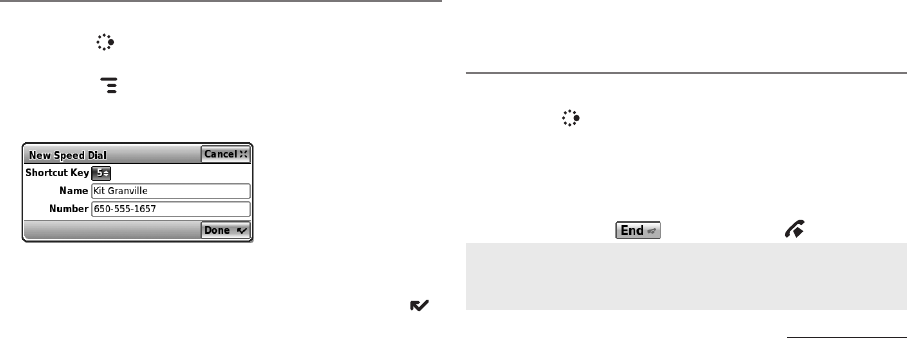
-41-
Add a Number to Your Speed Dial List
1 Press JUMP to go to the Jump screen, then press the
trackball to open the Phone application.
2 Press MENU to open the menu. Select New Speed Dial to
open the New Speed Dial Entry dialog box. You can create
eight speed dial shortcuts.
3 Select a Shortcut Key from the pop-up menu. Only the
numbers available will appear in the pop-up menu.
4 Type the speed dial Name and Number, then select DONE .
5 To dial using the shortcut, from either the Phone application
or the Jump screen, simply press and hold the number on the
keyboard.
Check Your Voice Mail
1 Press JUMP to go to the Jump screen, then press the
trackball to open the Phone application.
2 Press and hold the 1 key (the speed dial shortcut assigned to
voice mail) to call your voice mailbox.
3 Follow the prompts to retrieve your messages.*
4 To hang up, select , or press END CALL .
To check your voice mail from another phone, dial your
mobile number and then press the (*) star key to interrupt the
greeting. At the prompt, type your password.
* Airtime charges apply.

-42-
Change Your Phone Ringtone
1 Press JUMP to go to the Jump screen, then press the
trackball to open the Phone application.
2
Press MENU to open the Phone menu. Select Settings >
General.
3 Highlight the Incoming Call Ringtone pop-up menu, then
press the trackball. The menu reveals the ringtone categories.
First highlight a category, then press the trackball to open the
ringtones submenu. As you scroll through the songs, you can
preview each song by hovering over it for a few seconds.
4 When you have decided on a ringtone, press the trackball to
select it. Press DONE to assign your new ringtone.
Assign caller-specific ringtones from the Address Book,
Edit Contact Details pages.
Import Contacts from Your SIM Card
If you already have a SIM card from T-Mobile, you can import
the phone numbers you have stored on the SIM card into your
device’s Address Book. First, insert the SIM card with the
contacts into your device, then:
1 Press JUMP to go to the Jump screen. Scroll to highlight
Address Book, then press the trackball.
2 Press MENU , then select Settings > Import SIM Contacts.
3 The SIM Import dialog will alert you when the import is
complete.
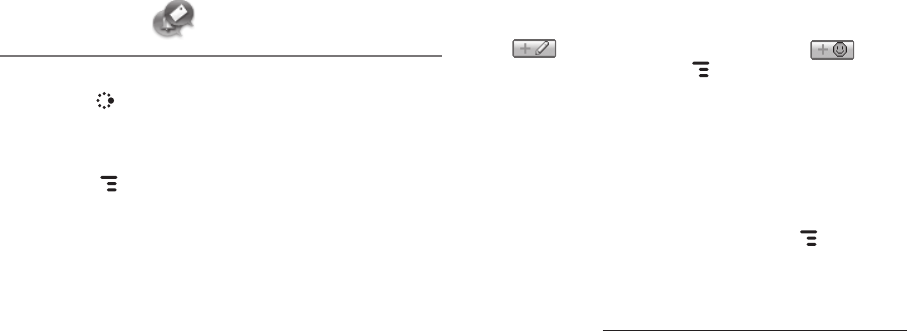
-43-
Text Messaging
Send a Text Message
1 Press JUMP to go to the Jump screen. Scroll to highlight
Phone Messaging, then press the trackball to open the
second-level ring of applications. Highlight Text Messaging,
then press the trackball.
2 Press MENU + N to open a message Compose screen.
3 Address your message using the recipient’s phone number,
or start typing their name to bring up Address Book matches.
Add more recipients by typing a comma (,) or semicolon (;) in
the To field.
4 Use the trackball to scroll to the message body; type your
message or use one of the Prewritten Messages by selecting
the button. Add Smileys by selecting the button.
To attach a vCard, press MENU and select Attach vCard.
Select a contact from the list that appears and their vCard will
be attached to your message.
If your message is larger than the limit for a single text
message (around 160 characters), the message will be sent in
parts but received as one. The Compose screen will display
how many characters you’ve typed as you go.
5 When ready to send, either select the Send button at the
bottom of the Compose screen, or press MENU + M.*
* Separate charges apply to send and receive text messages.

-44-
Picture Messaging
Send a Picture Message
Each message you create can contain up to three multimedia
slides, with each slide containing a text, sound (voice note or
song), and picture attachment. To create, preview, then send a
picture message, follow the steps below. Be creative!
1 Press JUMP to go to the Jump screen. Scroll to highlight
Phone Messaging, then press the trackball to open
the second-level ring of applications. Highlight Picture
Messaging, then press the trackball.
2 Press MENU to open the menu. New Message is selected by
default; press the trackball to open the Compose screen.
3 Address your message using the recipient’s phone number,
or start typing their name to bring up Address Book matches.
Add more recipients by typing a comma (,) or semicolon (;)
in the To field. Type a Subject for the entire message. (Each
slide you create can have its own message as well.)
4 Create your first slide:
n Add the slide’s message by typing in the text field.
n Add a voice recording by selecting the “Add Voice Note”
icon . In the dialog box that opens, select Start
Recording to begin the voice recording. Speak into the
microphone (next to the trackball). When finished, select
DONE to attach it to your slide.
n
Add an image by selecting the “Add Image” icon
. Your
Browse Photo Albums screen will open, where you can

-45-
select one photo. After selecting the photo, press MENU
then select Use Checked to attach it to the slide.
n Add a song to your slide by selecting the “Add Sound”
icon . The ringtone selector will open. Select a
song from the ringtone pop-up menus. (Due to format and
copyright limitations, not all ringtones available in other
applications will be available as attachments to picture
messages.)
n Use the sec(s) pop-up menu to select how long you want the
slide to play. Note that if you have attached a voice note that
plays longer than the menu setting, the voice note will be cut
off when played.
5 To create another slide, select the “Add Slide” icon .
Add up to three slides by repeating Step 4.
6 To preview your message, select the Preview button. You can
edit the attachments from the Compose screen: first highlight
the attachment, then press and hold the trackball to bring up
the context menu containing edit options.
7 When ready to send, either select the Send button at the
bottom of the Compose screen, or press MENU + M.
Web Browser
Browse the Web
1 Press JUMP to go to the Jump screen. Scroll to highlight
Web Browser, then press the trackball.
2 Start typing the address of the Web page you wish to visit. The
Go To dialog box opens automatically, showing the address
you are typing.

-46-
3 The characters you type appear in the top field of the Go To
dialog box. Possible URL matches, and the option to search
for the text you type, appear in the drop-down menu.
4 To go to a Web page, you can either finish typing the
complete URL in the Go To dialog box then press Return; or,
roll the trackball to highlight a suggested URL in the drop-
down menu, then press the trackball.
To open Web pages faster, press MENU and select
Settings. Scroll down the Settings screen and clear the “Show
pictures” check box.
To increase the text size displayed on a page, press + 0;
to decrease the text size, press + 9.
Bookmark a Web Page
1 Open the Web page you want to bookmark.
2 Press MENU + N to open the Add Bookmark dialog box.
3 Edit the bookmark name if you wish, verify the URL and select
a folder in which to store the bookmark from the Folder pop-
up menu. (If you select New Folder, you’ll be prompted to give
the folder a name.)
4 Press DONE to save the bookmark.
Copy Text on a Web Page
You can copy all the text on a Web page by pressing MENU
+ A, then MENU + C. Copy only text you select by doing the
following:

-47-
1 Press and hold the SHIFT key for three seconds to enter “copy
text” mode. A blinking cursor (|) will appear.
2 Use the D-Pad to position the cursor where you want the text
selection to begin or end.
3 Press and hold the SHIFT key while using the D-Pad to select
text, starting from the cursor’s location. You can deselect the
text and exit “copy text” mode by rolling the trackball.
4 When finished selecting, press MENU + C. Now you can
paste (MENU + V) the text in any text box on the device.
Email
Send an Email Message
1 Press JUMP to go to the Jump screen. Scroll to highlight
Email, then press the trackball.
2 Press MENU to open the menu. New Message is selected by
default; press the trackball to go to the Compose screen.
3 The text cursor is in the To field; type the name or email
address of the person to whom you wish to send an email. If
you type a name, the Address Book will try to pull the correct
email address from your contact data. Add more To fields by
typing a comma (,) or semicolon (;). Open the menu to add a
CC or BCC.
4 Scroll to the Subject field and type the subject of your email.

-48-
5 Scroll to the message body and type your message.
To delete text in the forward direction, press the SHIFT +
DEL keys together. To delete the current line of text, press the
ALT + DEL keys together.
6 When ready to send, either select the Send button at the
bottom of the Compose screen, or press MENU + M.
Fetch Email from External Accounts
When you register your device account, you automatically
receive an email account that you can use immediately on either
your device or the Email application on the Desktop Interface.
Your email address is
username
@tmail.com, where
username
is
the name you selected during registration.
In addition, you can fetch email from up to three external POP3
or IMAP email accounts. You can also check some Internet email
accounts by using the Web Browser, as described in “Fetch Email
Using Your Device’s Web Browser” on page 51.
The instructions that follow explain how to use your device to
fetch email from external accounts. You can also set up accounts
from the Email application on the Desktop Interface.
1 Press JUMP to go to the Jump screen. Scroll to highlight
Email, then press the trackball.
2 Press MENU then select Settings > Accounts to open the
Accounts screen.
3 On the Email Accounts screen, press MENU then select New
Account to open the New Account screen.
4 Type your email account information in the fields on this New
Account screen. Read the sections below for more details on
each field:
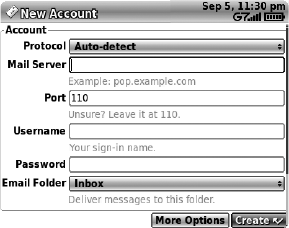
-49-
Protocol pop-up menu Select the protocol your mail server
uses or the type of account from this pop-up menu. Select
Auto-detect if you don’t know which one to pick. Note that if
you select a specific account type, then the next two fields
(mail server name and port value) will fill in automatically.
Mail Server field If the mail server name is not provided
automatically after you have selected the account protocol,
then you must provide the name of the mail server in this field.
Many people don’t know the name of their mail server. If you
don’t know yours, your email provider will be able to tell you,
or you can refer to the following table for examples.

-50-
Some popular Web-based email providers and their Mail
Server names are provided below for your convenience. If
you have an email account through your ISP, contact them for
assistance. Note that some ISPs (including Yahoo!) require
additional configuration or charge a fee to download email.
Web Email Provider Mail Server Name
Yahoo!® Mail pop.mail.yahoo.com
Mail.com pop1.mail.com
Softhome.net mail.SoftHome.net
Gmail pop.gmail.com
Port field Unless your email provider has specified otherwise,
do not alter this value. Note that if you have selected a specific
account type from the Type pop-up menu, the correct port value
will be supplied automatically.
Username and Password fields Type your email account
username and password.
Email Folder pop-up menu Select the folder to which you
want your account email delivered. To create a folder, select
New Folder.
5 When you’ve completed all the fields on the screen, select the
More Options button at the bottom of the screen.
6 In the General group box, the Collect email from this account
check box is selected by default. If at any time you want to
stop fetching messages from this account, simply clear this
check box.
If you want to Remove retrieved email from server after it is
fetched to your device, select this check box.

-51-
7 Scroll to the bottom of the screen to the From Name field:
If you leave these fields blank, your default POP or IMAP
account name and address will be used. Specify alternative
names or addresses in these fields as you wish.
8 Select the Copy Outgoing Messages check box to have every
message sent from this account copied to another email
address. Specify either CC or BCC (from the pop-up menu),
then type the email address in the field.
9 Save your information by selecting Create; or simply press
DONE .
10 Wait until you receive a confirmation message on the Email
Accounts screen before attempting to send messages from
this email account.
Fetch Email Using Your Device’s Web Browser
If there is a Web interface to your email account, you can use
your device’s Web Browser application to sign in to those
accounts and check your email. A couple popular email Web
sites are listed below:
n Yahoo!® Mail – http://mobile.yahoo.com/home
n MSN Hotmail – http://mobile.msn.com/hm/folder.aspx
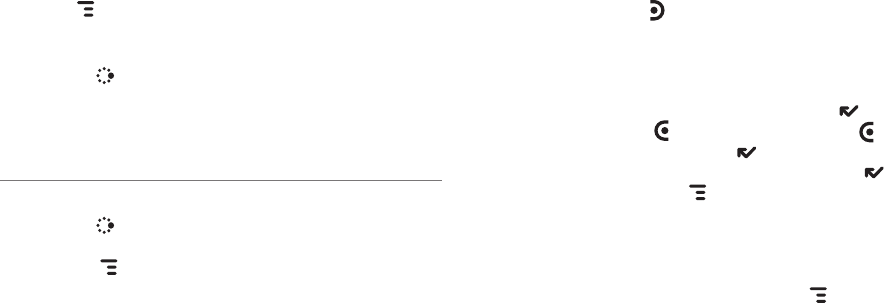
-52-
Press MENU + K to open the Bookmarks screen; some sites
may have been bookmarked for you. To go directly to an email
Web site, do the following:
1 Press JUMP to go to the Jump screen. Scroll to highlight
Web Browser, then press the trackball.
2 Begin typing the URL for your Internet email account. Your
entry will be inserted in the Go To dialog box automatically.
3 Press the trackball to go to the Web site’s sign in page.
Attach a Photo, Sound, or vCard to an Email Message
1 Press JUMP to go to the Jump screen. Scroll to highlight
Email, then press the trackball.
2 Press MENU + N to open the Compose screen. Complete
the To, Subject, and Message fields.
3 Do one of the following to attach a photo, vCard, or sound:
n Attach Photo - Press to open your photo albums. Roll
the trackball to highlight a photo, then press to select
a photo to send. You can select multiple photos. Each
selected photo will display a check mark in the corner of
the photo. When you’ve finished selecting photos, open
the menu and select Use Checked or press DONE .
n Attach Sound - Press to open the recorder. Press
again to start recording and DONE to stop recording.
Review your recording then, when ready, press DONE .
n Attach vCard - Press MENU and select Attach > vCard.
Highlight the contact you want to send, then press the
trackball to select it.
5 Your email message returns to the screen, including attached
photos. (To remove an attachment, highlight it and press the
DEL key.) Select the Send button or press MENU + M to
send.
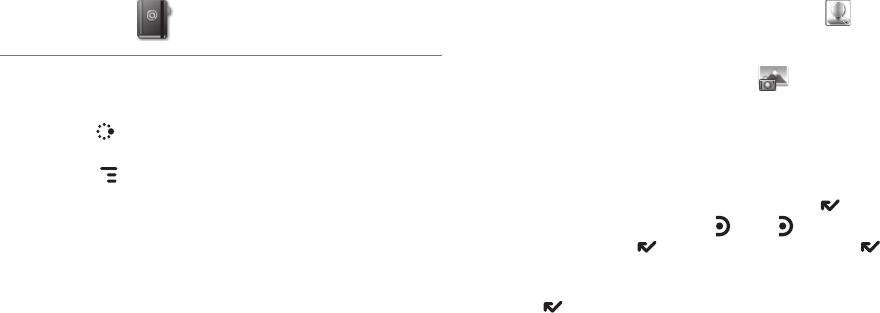
-53-
Address Book
Add a Contact to the Address Book
You can store up to 2000 contacts in your Address Book.
1 Press JUMP to go to the Jump screen. Scroll to highlight
Address Book, then press the trackball.
2 Press MENU to open the menu. New Contact is selected by
default; press the trackball to go to the New Contact Identity
screen.
3 To create a contact, you only need to type basic “identity”
information: a First or Last name. On this screen you can also
provide a Middle name and a Nickname, as well as select an
icon.
4 To select an icon, roll the trackball up to highlight , then
press the trackball to open the icon selector. Highlight the
icon you want, then press the trackball to select it.
To assign a Photo Caller ID icon, select from the icon
selector, which will open the Browse Photo Albums screen.
Then, from this screen:
n To select a photo already in an album, roll the trackball to
highlight the photo you want to associate with the contact,
then press the trackball to select it (a check mark will
appear in the corner of the photo). Press DONE .
n To capture a new photo, press . Press again to
capture, then DONE to save the photo. Press DONE
again to view the album contents. Select the photo (a
check mark will appear in the corner of the photo). Press
DONE .

-54-
A smaller version of the photo now appears on the Identity
screen and will be used to identify that contact on incoming
call notifications.
5 When finished with the Identity screen, select DONE . You
advance to the next New Contact screen, in which you can
type or select additional contact information.
6 Scroll through the New Contact fields (Personal Info, Phone,
Email, and so on), selecting Add or Edit to open screens in
which you can add contact details. Set a custom ringtone for
your contact in the Phone number screen.
7 When finished, press DONE to save your new contact
information.
Communicate with a Contact
From the Address Book’s “Browse Contacts” screen, highlight
a contact, then press and hold the trackball. A menu opens that
lists all the communication options available for that contact.
Select the action you want to take.
You can also quickly send an email, instant message, text
message, or place a call to a contact from a contact’s “Details”
screen:
1 Go to the Address Book and select a contact with the
trackball. Their Contact Details screen opens.
2 The Contact Details screen lists all the information that
you have stored for this contact: phone numbers, email
addresses, IM screen names, and so on.

-55-
3 To open a communication with this contact, highlight the
phone number or address of interest, then press the trackball
to select it. A menu opens with relevant communication
options.
4 Select the option to send the call, open a compose screen, or
an IM conversation.
To edit or add contact details, select the Edit button on the
Contact Details screen.
Import Address Book Contacts
If you have a SIM card from T-Mobile with contact information
stored on it, you can import that information to your device by
following the instructions in “Import Contacts from Your SIM
Card” on page 42 of this guide.
If you have existing contact information stored in a Personal
Information Management (PIM) application, you can import that
data to your Address Book on the device and Web. To do this,
first go to your Address Book on the Web:
1 Go to your desktop or laptop computer and sign in to the
Desktop Interface by following the instructions in the Start
Guide.
2 From your Jump page, click Address Book.
3
Click Import in the Address Book sidebar. The Import page
opens.
4 The Import page includes step-by-step instructions for
completing the import process. The following file types
(exported formats) can be imported: Microsoft Outlook for
PC (.txt file), Microsoft Outlook Express for Mac (.txt file),

-56-
Microsoft Entourage for Mac (.txt file), Palm Desktop for PC
(.txt/.tab file), Palm Desktop for Mac (.txt/.tab file)
5 After you click the Import button, your contacts are imported
to your Web Address Book then sent to your device via the
network. Make sure your device has a wireless connection;
then, after 2 to 3 minutes, check your device to confirm that
your new contacts have arrived.
Set and Send “My vCard”
You can set one of your contacts to be “you”, so that you can
send “My vCard” to others easily.
1 Press JUMP to go to the Jump screen. Scroll to highlight
Address Book, then press the trackball.
2 Scroll to highlight the contact you want to set as “you”, then
press MENU and select vCard > Set as My vCard. On the
Browse Contacts screen, you will now see a icon next to
your name.
3 To send your vCard, from the Browse Contacts screen, press
MENU and select vCard > Send My vCard > via Email
[MENU + M], or Text, or Bluetooth [MENU + Y]. For Email
and Text, a compose screen opens. For Bluetooth, a dialog
opens that allows you to select the receiving device.
4 To change or remove the “My vCard” setting, first press
MENU and select vCard > Clear My vCard. To set a different
contact as “My vCard”, highlight the contact, then press
MENU and select vCard > Set as My vCard.
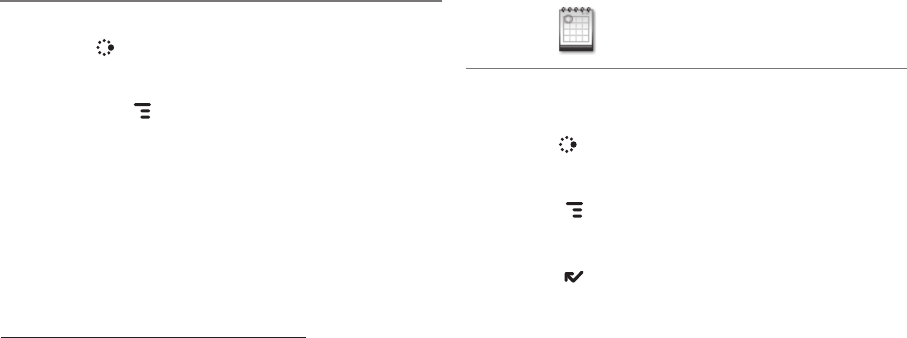
-57-
Send any Contact’s vCard
1 Press JUMP to go to the Jump screen. Scroll to highlight
Address Book, then press the trackball.
2 Scroll to highlight the contact whose vCard you want to send,
then press MENU and select vCard > Send Contact’s vCard
> via Email, or Text*, or Bluetooth. For Email and Text, a
compose screen opens. For Bluetooth, a dialog opens that
allows you to select the receiving device.
Calendar
Add an Event to Calendar
You can create and store up to 1000 events in your Calendar.
1
Press JUMP to go to the Jump screen. Scroll to highlight
Organizer, then press the trackball to open the second-level ring
of applications. Highlight Calendar, then press the trackball.
2 Press MENU + N to open an Event Details screen.
3 Name your event, type a location, assign a duration, add
repetitions, reminders, and notes as applicable.
4 Press DONE to save the event. It will now appear on your
Upcoming (if it’s scheduled within the next seven days), Daily,
Week, or Month views.
* Separate charges apply to send and receive text messages.

-58-
5 To view your schedule, select one of the “Views” from the
menu. Each view has a keyboard shortcut:
n Upcoming (next seven days) MENU + 0
n Day MENU + 9
n Week MENU + 8
n Month MENU + 7
n Year MENU + 6
n Trash MENU + T
Notes
Create a Note
You can create and store up to 50 notes. Each note can be up to
8000 characters, which is about four pages in a paperback.
1 Press JUMP to go to the Jump screen. Scroll to highlight
Organizer, then press the trackball to open the second-level
ring of applications. Highlight Notes, then press the trackball.
2 Press MENU + N to open a blank note. Type your note; it is
saved as soon as you type it.
3 Press the trackball to fold your note; press again to unfold.
Notes must be unfolded before you can edit them.

-59-
Send a Note via Email
1 Press JUMP to go to the Jump screen. Scroll to highlight
Organizer, then press the trackball to open the second-level
ring of applications. Select Notes.
2 Create a new note or highlight an existing note.
3 Press MENU and select Send Note or press MENU + M. A
compose screen opens with the note in the message body;
complete the message and Send.
To Do
Add a Task
You can create and store up to 50 tasks.
1 Press JUMP to go to the Jump screen. Scroll to
highlight Organizer, then press the trackball to open the
second-level ring of applications. Highlight To Do, then
press the trackball.
2 Press MENU + N to open a blank task screen. Create
your task.
3 Press DONE to save the task.
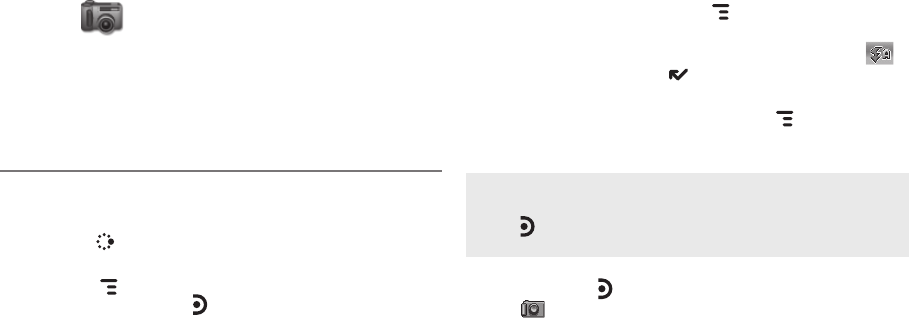
-60-
Camera
Your device comes with a built-in 1.3 megapixel camera with
flash. You can store up to 1.75 MB of photos on your device’s
internal memory and more on your microSD card. The number
you can store will depend on the capacity of the card and the
size of the photo (Small, Medium, or Large). Remember that you
might be sharing the card’s capacity with sound files as well.
Take a Photo
Before you capture a photo, be sure your camera lens is clean!
1 Press JUMP to go to the Jump screen. Scroll to highlight
Camera, then press the trackball.
2 Press MENU and select Capture New, or simply press
the right shoulder button . The screen now acts as the
“viewfinder”.
3 To set the photo size, press MENU and select Large (1280 x
1024), Medium (640 x 480), or Small (320 x 240).
4 To set AutoFlash on or off, open the Flash pop-up menu .
When finished, press DONE to save.
5 By default, the photo will be saved to the Memory Card
Album. To save to your device, press MENU and select
Capture to. From the submenu select Device Album, or
another album you created on the memory card.
To take a photo of yourself, center your image in the small
mirror on the back of the device and press the right shoulder
button to capture. Remember the “right shoulder button”
will be on your left as you’re looking at the back of the device.
6 When you’re ready to take your photo, press the right
shoulder button or use the trackball to select the capture
icon .

-61-
7 The photo preview appears on the display. You can:
n Press CANCEL to discard it;
n Press DONE to save it to the album you’ve selected; or,
n Select to send it via an Email or Picture message.
8 To return to the Browse Albums screen, select or press
DONE .
Send Photos by Email or Picture Message
In addition to being able to send a photo after capture (read
“Take a Photo”, step 7 above), you can attach one or more
photos in your Photo Albums to either an email message or a
picture message while composing. For instructions, read “Attach
a Photo, Sound, or vCard to an Email Message” on page 52, and
“Send a Picture Message” on page 44.
To select all photos in an album, open or highlight the
album, then press MENU and select Edit > Check All in
Album, or press MENU + A. To uncheck, select Edit >
Uncheck All or press MENU + U.
Use Photo for Caller ID or Key Guard Background
You can assign the photos you’ve saved in one of your photo
albums as a Caller ID or a key guard background image.
To assign a photo as a Caller ID:
Follow the instructions in “Add a Contact to the Address Book”,
step 4, on page 53.

-62-
To assign a photo as a key guard background image:
1 Press JUMP to go to the Jump screen, then press MENU
and select Settings > Key Guard & Security.
2 Press the trackball with the Select Image pop-up highlighted.
Select to go to your Photo Album.
3 Select the photo you want to use as the key guard background
by highlighting it then pressing the trackball. A check will
appear in the corner of the photo.
4 Press DONE to make the assignment, then press DONE
again to dismiss the Key Guard & Security screen.
Music Player
Use the music player to play sound files that you have stored on
your microSD card. You can use a memory card of any capacity.
Remember that you might be sharing the card’s capacity with
Camera photos.
The music player will play MP3, WAV, MIDI, WMA, AAC
(MP4), XMF, RMF, AIFC, IMY, and AMR files; it will not play
RAM, M4P, FLAC, RA or any other file that is not listed above.
Copy Music to the Memory Card
Before you can copy any songs to your memory card, you must
insert a card into the microSD card slot on your device. For
instructions, read “Memory Card Slot” on page 17. Once your
card is installed, do the following:

-63-
1 Connect your device to your computer with the USB cable
provided in the box. Read more in “USB/Power Port” on page
18.
2 On your computer, find the mounted USB drive and open it.
3 You should see a folder at the top-level named “Music”. If you
do not see this folder, then create it.
4 You’re ready to copy sound files onto the memory card. It’s
best if you organize your songs in sub-folders under the
“Music” folder. For example, you could create one folder for
each album or artist.
5 Copy sound files from your computer’s hard drive onto your
device’s mounted USB drive, in the folders under “Music”.
6 When finished copying, close the USB drive window and
“unmount” the drive as required by your computer.
7 Remove the USB cable from your device and computer. Read
the next section to learn how to play your songs!
Play Songs
Listen to your songs using either the device speaker or the stereo
headphones included in the box.
1 Press JUMP to go to the Jump screen. Scroll to highlight
Music Player, then press the trackball.
2 The Browse Music screen appears. Your music is organized
into categories with the number of songs in each shown in
parentheses. (Songs are categorized automatically, based on
information contained in the song file itself.)
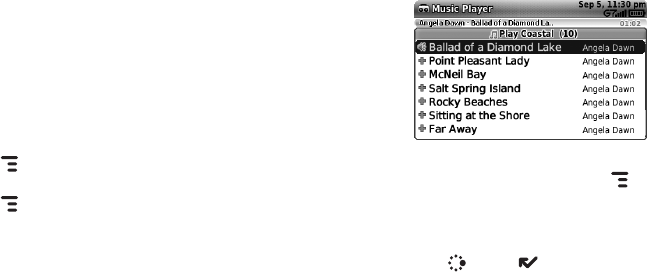
-64-
3 Scroll to highlight a category, then press the trackball to “drill
down” to the next level. Here you might see songs or more
categories.
At any level of the Browse Music screen, simply select the
category or song you want to play, and it will be added to the
“Play Queue” (all the songs that are waiting to be played). You
can also use the shortcuts:
MENU + P - Plays selection (interrupts currently-playing
song)
MENU + Q - Queues selection (waits its turn in the list to
play)
The progress of the song currently playing is shown at the top
of the screen:
4 Songs playing in a list will not repeat, but you can change
this setting by pressing MENU then selecting Shuffle and
Repeat. Choose from Shuffle, Repeat, Repeat 1, or No
Repeat.
5 To control song play from anywhere on your device, press
JUMP + DONE and the mini music player will open. Read
more in “Mini Music Player” on page 11.
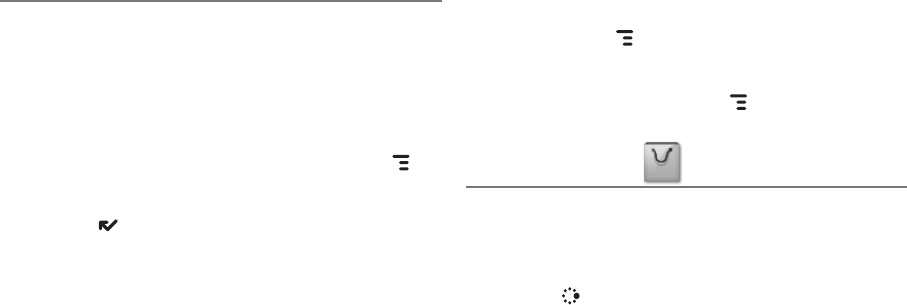
-65-
Create a Playlist
You can create as many playlists as you wish and edit them at any
time. Here’s how:
1 From the Browse Music screen, select one of the top-level
categories, then find a song, artist, or album you want in a
playlist.
2 With the song, artist, or album highlighted, press MENU
and select Add to Playlist > New Playlist.
3 Give your new playlist a name in the dialog box that opens.
Press DONE to save the playlist.
Now your newly-created playlist will be included in the Playlists
category on the Browse Music screen.
n To add songs to this or any playlist, highlight a song, artist, or
album, press MENU and select Add to Playlist > “Playlist
Name”.
n To remove a song from an existing playlist, open the playlist,
then highlight the song. Press MENU and select Remove
from Playlist.
Download Catalog
Download Items from the Catalog
Download ringtones, applications, games, and more from the
Catalog! You’ll find that browsing the Catalog and purchasing
items is easy and fun:
1 Press JUMP to go to the Jump screen. Scroll to highlight
Download Catalog, then press the trackball.

-66-
2 Wait while the latest Catalog contents load... then use the
trackball to scroll through the categories. The categories are
organized like the Jump screen in a “ring” on the left, with
each category’s splash screen on the right. Highlight, then
press the trackball to open a category’s Browse Items screen.
If you know the name of the item you’re interested in, press
MENU + F to open the Find dialog box. Type the name of the
item then select Find. Matches will appear; select the item of
interest to open its Item Details screen.
3 Individual items are grouped into folders. Highlight a folder
then press the trackball to open a folder’s items. Once you
find an item you’re interested in, highlight the item then press
the trackball to open the Item Details screen.
4 To listen to a brief sample of a ringtone or view sample screen
shots of an application before you purchase it, select the
Preview button. Select Purchase to step through the simple
on-screen purchase process.
5 Once purchased, your item will be downloaded to your
device, network connectivity permitting. You’ll be notified
once the download is complete. Note that applications
require “installation”, an automatic process that does involve
a restart of your device.
6 If your item is not delivered immediately, you can check the
download process from the Downloads screen, described
below.
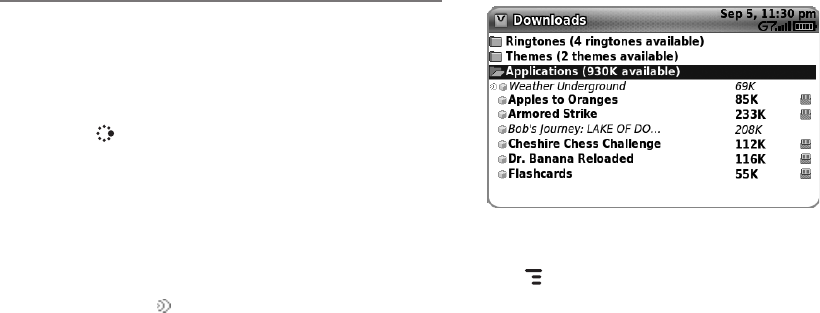
-67-
Manage Your Downloaded Items
To remove a downloaded item, check the download status of a
purchased item, or view a list of all the downloads you have made
through the Catalog (including details such as price, subscription
term, upgrade information), go to the Downloads screen:
1 Press JUMP to go to the Jump screen. Scroll to highlight
Download Catalog, then press the trackball.
2 Scroll to Downloads, then press the trackball to open the
Downloads screen.
3 All your downloads are listed on this screen, organized
into folders by categories. Highlight a folder then press the
trackball to reveal the items within.
4 Items currently being downloaded are shown in italic with the
“transmitting” icon: . Items that have been uninstalled are
shown in italic.
5 To view item details, highlight the item then press the
trackball. To discard any highlighted item permanently, press
MENU then select Discard.
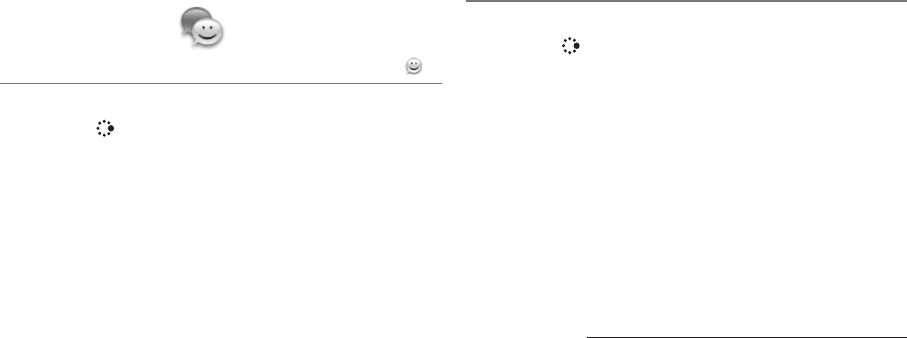
-68-
Instant Messaging
Use all the instant messaging applications at the same time !
Sign On
1 Press JUMP to go to the Jump screen. Scroll to highlight
Instant Messaging, then press the trackball to open the
second-level ring of applications. Highlight the IM application
of your choice, then press the trackball. The Sign On screen
appears.
2 Type your username and password (passwords are case-
sensitive), then select the Sign On button.
3 Your list of friends appears. You are ready to send an instant
message.
Send an Instant Message
1 Press JUMP to go to the Jump screen. Scroll to highlight
Instant Messaging, then press the trackball to open the
second-level ring of applications. Highlight the IM application
of your choice, then press the trackball.
2 Sign on with your username and password; the screen listing
all your IM friends’ usernames displays.
3 To start a conversation with a friend on your list, scroll to
highlight the friend’s username, then press the trackball to
start a conversation.
4 Type your message. When ready, press the Return key to
send.*
* Separate charges apply to send and receive instant messages.
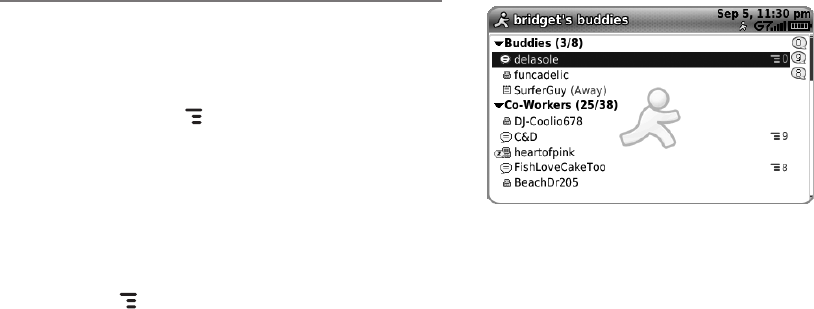
-69-
Switch Between IM Conversations
You can have up to 10 IM conversations open at the same time. If
you do have more than one IM conversation open, you can switch
between conversations quickly by doing one of the following:
n From Menu Press MENU + D to open the IM Conversations
submenu, which lists all your open conversations. Scroll to
highlight the conversation you want to open, then press the
trackball.
n Using Conversation Number Each open IM conversation has
a number (0-9), which is displayed in the IM Conversations
submenu, as well as on the screen displaying your list of
friends. From any screen in IM, including the IM splash
screen, you can quickly switch between conversations by
pressing MENU + the IM conversation number.
n From Friends List Screen On the screen listing all your
friends’ usernames, scroll to highlight the conversation to
which you want to switch, then press the trackball.
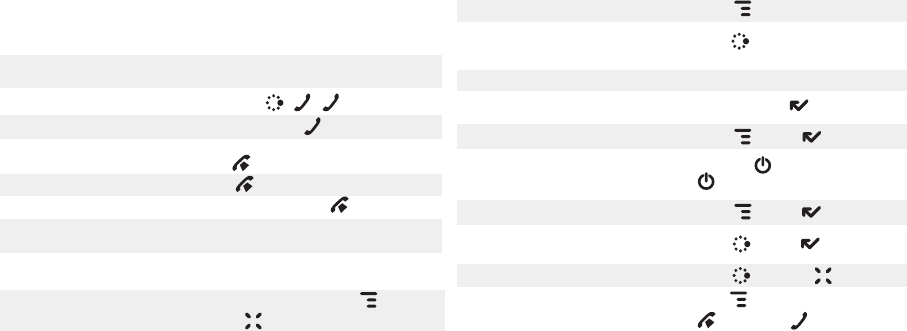
-70-
Keyboard Shortcuts
Call a speed dial number
Press and hold speed dial # on keyboard
while in Phone or on
Jump screen.
Redial last number Press JUMP , , .
Answer an incoming call Press trackball or .
Ignore an incoming call
(call will forward) Press .
Hang up active call Press .
Mute your device when ringing Press any key, except .
Create a new note, message,
event, task, to do, or contact Press MENU + M.
Insert Unicode character Press SYM key.
Discard item Highlight item, press MENU +
CANCEL .
Send a composed message Press MENU + M.
Open latest unread message Press JUMP + 0.
Delete all text in a single line Press ALT + DEL.
Put device in key guard mode Press and hold DONE two seconds.
Unlock device Press MENU + DONE .
Power device on/off Press and hold for three seconds.
Press twice to power off.
Open Sound Controls Press MENU + DONE .
Open mini music player Press JUMP + DONE .
Open Quick Jump menu Press JUMP + CANCEL .
Scroll page-by-page Hold MENU and roll trackball; or,
press to page up, to page down.

-71-
Troubleshooting
How do I know when my account has been activated?
Once your account has been activated, you will see a “Welcome”
message on your screen. If the Welcome message doesn’t
appear on your device within 48 hours after registering, contact
your T-Mobile Customer Care department.
In order to comply with airline regulations, how can I temporarily
disable wireless connectivity when traveling?
Remember to switch to “Airplane Mode” during aircraft takeoff
and landing. To turn off wireless connectivity (to comply with FAA
regulations) follow these instructions:
1 From the Jump screen, press MENU , and select Airplane
Mode > Turn Wireless Off.
2 Your device is now offline. Confirm offline status by looking at
the title bar; the radio icon and “OFF” should blink alternately.
Even without wireless connectivity, you can still access the
device applications and read email messages that already been
downloaded. However, you will not be able to send or receive
messages until you enable wireless connectivity again.
How can I protect my device from damage?
The best way to protect your device is to carry it with the display
closed, in the carrying case supplied in the box. You risk
damaging your device if you do not protect the display. Also,
water—even in small amounts or in the form of steam—can

-72-
seriously damage your device and charger, so keep your device
dry and away from potential water sources.
I needed to remove my battery, so I did. After I put the battery
back in my device, it powered up, but all my messages and other
data were gone. Is it all gone for good?
No, all your data is regularly saved to the Danger service so it
is safe. If you wait a few minutes, all your data will be restored
to your device. (Note, however, that any data you entered or
modified between the last save to the Danger service and when
you removed the battery will be lost.)
Chances are you removed the battery before powering off your
device. Every time you power off your device, your data is saved
to the device’s internal flash memory. However, if you remove
your battery before shutting down, your data will not be saved
to flash. It is, however, saved on an ongoing basis to the service,
which means your data is always backed up. However, for your
convenience, always power off your device before removing the
battery!
How can I improve radio reception when I’m in a “fringe”
coverage area?
Try the following to improve radio reception:
n Use the hands-free headset and position the phone away from
your body.
n Walk to a window if you are indoors.
n
Step outside of buildings that have high metal, concrete, or
earthen content, because they may absorb radio signals.

-73-
n Step away from metallic windows because they absorb RF
energy.
n Go to the highest spot possible to make the call.
n Step away from computers or electronic equipment.
n If you are in a car, first park, then try the call from outside the
car.
n If you are near or directly under a cellular/PCS radio tower,
walk at least one block away.
My device has not connected to the service for quite a while. Is
there anything I can do myself before calling Customer Care?
Yes, try powering your device off and on. After your device boots,
you’ll know you’ve connected to the service when you see the
in the title bar again.
What Web browsers do you support on the Desktop Interface?
Web browsers IE 5+ are supported on both the Windows and
Macintosh operating systems, as well as Firefox and Safari.
Why do the Web pages I open using the device’s Web Browser
application appear different from the pages I open on my
desktop computer?
The Web pages displayed on your device have been reformatted
so they are easier to read on a small display. The same or similar
information displays; it’s just laid out on the screen so that it’s
easier to view on your device.

-74-
What are the requirements for getting my other email accounts
to appear on my device?
To fetch messages from another email account, you must gather
the following information:
n Name of the remote email server (e.g., mail.example.com).
n Protocol used by the remote email server (e.g., POP, IMAP).
n Your username on the remote email server. (For example, if
your email address is joe@example.com, then your username
is “joe”.)
n Your password on the remote email server. This is the same
password you use to open the remote email directly.
Most Internet Service Providers and University email systems
work with the POP3 protocol. If you are not sure of the protocol,
use the Auto-detect setting, or you can call or email your remote
service and ask what protocol they support. The remote service
operators can also tell you the name of the remote email server.
Once you have all this information, set up your external account
by following the instructions in “Fetch Email from External
Accounts” on page 48 of this guide. Once set up, your remote
email account will be checked periodically and a copy of all new,
unread messages will be placed in the Email mailbox on your
device.
How secure is my account data on the Desktop Interface? There
may be sensitive information stored in contact information
(credit card numbers for example) that must be secure!
Information in your account is stored on servers in a data center
with enhanced security and firewall features. Please refer to the
T-Mobile Privacy Policy and the Danger® Service Privacy Notice
on page 90 for more information.

-75-
What should I do if I need a replacement part for my device or if I
need to have my device repaired?
Contact your T-Mobile Customer Care department for support.
How can I clean my device screen?
The screen on your device is coated with a protective layer of
polycarbonate. You can safely use warm soapy water, denatured
alcohol, or isopropyl alcohol to remove dirt and smudges from
your screen. Be sure to use a very soft cotton cloth, such as an
old t-shirt, to prevent scratching when wiping the screen.
How do I report a lost device?
Call your T-Mobile Customer Care department to report the
lost device as soon as possible! T-Mobile will disable your lost
device and your existing data will remain stored on the service,
assuming no one has tampered with the data since you lost the
device. When you receive your new device, your account data
will be downloaded to it automatically after you sign in with your
existing username and password.
The device is not charging when I connect it to a personal
computer using the USB cable. What’s wrong?
Some personal computers are not able to charge your device
using the USB cable. If this is the case with your computer, when
you attach your device to the computer, you will see an alert on
the device telling you that you are receiving a USB charge that is
too low for charging your device. Instead, use the power adapter
included in the box for charging.

-76-
Handling and Safety
Precautions
The Sidekick is a mobile computing device that may break if
dropped, subjected to severe shock, or exposed to water. Please
handle the device carefully and read the precautions listed
below. These precautions provide essential information for the
safe handling of the product and for the protection of the users
and others from possible harm.
! During a call, the sound level on your device may vary,
depending on how you are routing the sound. Keep the volume
at a moderate level to prevent damage to your hearing, and be
careful not to switch accidentally to speakerphone (by pressing
the right shoulder button) while the phone is against your ear.
Battery Handling
n Your device uses a removable lithium-ion battery. Lithium-ion
batteries are recyclable. Never dispose of the battery or the
unit by incineration or ordinary waste.
n Always turn off your device before removing the battery.
n Never attempt to disassemble or modify the battery.
n Never touch any fluid that may leak from the removable
battery, because doing so may result in injury to the skin or
eyes.
n Never drop your device or subject it to severe shock. This may
cause the removable battery to leak, ignite, and/or rupture.
Always immediately remove your device from the vicinity of
any open flame in the event the built-in battery leaks or emits
an unusual odor.
-77-
Device Handling and Use
n Never attempt to disassemble, repair, or modify your device.
Such action may result in bodily injury, or damage to the unit
or other property.
n Never touch liquid that might leak from a broken liquid crystal
display (LCD), because doing so may cause a skin rash.
n Keep the volume at a moderate level to avoid damage to your
hearing.
n Never dispose of your device with ordinary waste.
n Never allow infants, small children, or animals within reach of
your device.
n Switch off your device or put your device in “Airplane Mode”
when in an aircraft. The use of the device in an aircraft may be
dangerous to the operation of the aircraft, disrupt the cellular
network, and is illegal. Failure to observe this instruction may
lead to suspension or denial of cellular telephone services to
the offender, or legal action, or both.
n Check with your doctor if you have a pacemaker or hearing
aid to make sure you can safely use the device’s cellular and
Bluetooth radio frequencies.
n Certain locations (e.g., hospitals) may restrict the use of any
device that emits low-level RF energy. Always comply with
posted prohibitions of the use of RF-emitting devices.
n Do not use the device when at a refuelling station.
n Observe restrictions on the use of radio equipment in fuel
depots, chemical plants, or where blasting operations are in
progress.
n
It is advised that the device not be used by a driver while the
vehicle is moving, except in an emergency. Speak only into a
-78-
fixed, neck-slung or clipped-on microphone, or Bluetooth head-
set when it would not distract your attention from the road
.
n Never allow any metallic objects (e.g., staples, paper clips) to
become inserted into your device, as this could result in the
generation of excess heat or fire.
n Never use or store your device in the following locations:
- Anywhere it may be exposed to water (e.g., bathroom, sauna)
- Conditions of high humidity (e.g., rain or fog)
- Conditions of extreme high temperatures (e.g., near fire, in a
sealed car)
- In direct sunlight
- Locations or sites subject to strong vibration
n Using this device for long periods of time (e.g., playing games)
may harm your hands or eyes. For your health and safety, take
a 10-15 minute break every hour.
n If you have experienced seizures or blackouts that are caused
by watching flashing lights, consult a doctor before using this
device.
n Use your device in locations with the following ambient envi-
ronmental condition:
- Normal operation: 0ºC to 40ºC (32ºF to 104ºF), with humidity
of 30% to 80%
Battery Charger Handling
n The device is intended for use when supplied with power from
the battery charger included in the box with your device, or via
a USB cable to an approved USB host. Other usage will invali-
date any approval given to this device and may be dangerous.
n Charge the device within the temperature range of 5 to 35 de-
grees Celsius, or 41 to 95 degrees Fahrenheit, for the fastest
charging time.

-79-
n Never place the battery charger on any surface that can be
marred by exposure to heat; always place the battery charger
on a heat-insulating surface.
n Never use a battery charger that has received a sharp blow,
been dropped, thrown from a speeding vehicle, or is otherwise
damaged; doing so may damage your device.
n Never place the battery charger adjacent to any heat source.
n Never leave the battery charger close to an open container of
liquids.
n Never use a worn or damaged battery charger cable or plug,
or a worn or damaged extension cord or plug.
n When traveling abroad, never plug the battery charger into
a power source that does not correspond to both the voltage
and frequency specified on the charger.
n
A
lways confirm that the battery charger plug has been fully in-
serted into the receptacle to ensure a secure electrical connection.
n In the event of any unusual odor or smoke, always immediately
disconnect the battery charger from the device and the power
outlet, then power off the device.
n It is normal for the battery charger to become warm when
charging. Disconnect the battery charger from the outlet when
not in use.
n Never attempt to disassemble or repair an battery charger,
power supply cables, or plugs, because doing so exposes you
to electric shock.
! RISK OF EXPLOSION IF BATTERY IS REPLACED BY AN
INCORRECT TYPE. DISPOSE OF USED BATTERIES ACCORDING TO
THE FOLLOWING INSTRUCTIONS:
BATTERY DISPOSAL THIS PRODUCT CONTAINS A LITHIUM-
ION BATTERY. THIS BATTERY MUST BE DISPOSED OF PROPERLY.
CONTACT LOCAL AGENCIES FOR INFORMATION ON RECYCLING
AND DISPOSAL OPTIONS IN YOUR AREA.

-80-
Regulatory and Compliance
Information
Regulatory Compliance Information for
North America
FCC Declaration of Conformity
Model PV250, manufactured by Sharp Corporation, complies with part
15 of the FCC Rules.
Operation is subject to the following two conditions: (1) This device may
not cause harmful interference, and (2) this device must accept any
interference received, including interference that may cause undesired
operation.
Responsible Party:
SHARP ELECTRONICS CORPORATION
Sharp Plaza
Mahwah, New Jersey 07430
TEL: 1-800-BE-SHARP
FCC Notice
This equipment has been tested and found to comply with the limits for
a Class B digital device, pursuant to Part 15 of the FCC Rules. These
limits are designed to provide reasonable protection against harmful
interference in a residential installation. This equipment generates, uses
and can radiate radio frequency energy and, if not installed and used
in accordance with the instructions, may cause harmful interference to
radio communications. However, there is no guarantee that interference
will not occur in a particular installation. If this equipment does cause

-81-
harmful interference to radio or television reception, which can be
determined by turning the equipment off and on, the user is encouraged
to try to correct the interference by one or more of the following
measures:
n Reorient or relocate the receiving antenna.
n Increase the separation between the equipment and receiver.
n Connect the equipment into an outlet on a circuit different from that
to which the receiver is connected.
n Consult the dealer or an experienced radio/TV technician for help.
Modifications not expressly approved by the manufacturer could void
the user’s authority to operate the equipment. This transmitter must
not be co-located or operated in conjunction with any other antenna or
transmitter.
Exposure to Radio Frequency (RF) Signals
THIS MODEL DEVICE MEETS THE GOVERNMENT’S REQUIREMENTS
FOR EXPOSURE TO RADIO WAVES.
Your wireless device is a radio transmitter and receiver. It is designed
and manufactured not to exceed the emission limits for exposure to radio
frequency (RF) energy set by the Federal Communications Commission
of the U.S. Government. These limits are part of comprehensive
guidelines and establish permitted levels of RF energy for the general
population. The guidelines are based on standards that were developed
by independent scientific organizations through periodic and thorough
evaluation of scientific studies. The standards include a substantial safety
margin designed to assure the safety of all persons, regardless of age
and health.
The exposure standard for wireless mobile phones employs a unit of
measurement known as the Specific Absorption Rate, or SAR. In the

-82-
United States and Canada, the SAR limit for mobile devices used by
the public is 1.6 watts/kg (W/kg) averaged over one gram of tissue. The
FCC has granted an Equipment Authorization for this wireless device
with all reported SAR levels evaluated as in compliance with the FCC RF
emission guidelines. For this PV250 model, the highest SAR value when
tested for use at the ear is 0.89W/kg and when worn on the body, as
described in this guide, is 1.34W/kg. SAR information for this device is
on file with the FCC and can be found under the Display Grant section of
http://www.fcc.gov/oet/fccid after searching on FCC ID: APYNAR0063
for the PV250 model (850/900/1800/1900 MHz).
For body-worn operation, to maintain compliance with FCC RF
exposure guidelines, use the supplied carrying case. Use of non-
approved accessories may violate FCC RF exposure guidelines and
should be avoided. When carrying the device on your person, it is
recommended to turn the screen display in toward the body in order to
minimize RF exposure and maximize antenna efficiency.
Hearing Aid Compatibility with Mobile Phones
When some mobile phones are used near some hearing devices (hearing
aids and cochlear implants), users may detect a buzzing, humming,
or whining noise. Some hearing devices are more immune than others
to this interference noise, and phones also vary in the amount of
interference they generate.
The wireless telephone industry has developed ratings for some of their
mobile phones, to assist hearing device users in finding phones that
may be compatible with their hearing devices. Not all phones have been
rated. Phones that are rated have the rating on their box or a label on the
box.
The ratings are not guarantees. Results will vary depending on the user’s
hearing device and hearing loss. If your hearing device happens to be
vulnerable to interference, you may not be able to use a rated phone
successfully. Trying out the phone with your hearing device is the best
way to evaluate it for your personal needs.

-83-
M-Ratings: Phones rated M3 or M4 meet FCC requirements and are likely
to generate less interference to hearing devices than phones that are not
labeled. M4 is the better/higher of the two ratings.
T-Ratings: Phones rated T3 or T4 meet FCC requirements and are
likely to be more usable with a hearing device’s telecoil (“T Switch” or
“Telephone Switch”) than unrated phones. T4 is the better/higher of the
two ratings. (Note that not all hearing devices have telecoils in them.)
Hearing devices may also be measured for immunity to this type of
interference. Your hearing device manufacturer or hearing health
professional may help you find results for your hearing device. The
more immune your hearing aid is, the less likely you are to experience
interference noise from mobile phones.
Regulatory Compliance Information for
Europe
EU Declaration of Conformity
Hereby, Sharp Corporation, declares that model PV250 is in compliance
with the essential requirements and other relevant provisions of Directive
1999/5/EC.
A copy of the original declaration of conformity can be found at the
following Internet address:
http://sharp-world.com/products/wireless_pda/index.html

-84-
Recycling Information
The RBRC™ Battery Recycling Seal on the Lithium-ion (Li-ion) battery/
battery pack indicates UTStarcom is voluntarily participating in an
industry program to collect and recycle these battery/battery packs at
the end of their useful life, when taken out of service in the United States
or Canada. The RBRC™ program provides a convenient alternative to
placing Li-ion batteries into the trash or municipal waste stream, which is
illegal in some areas. Please call 1-800-822-8837 for information on Li-ion
battery recycling in your area. UTStarcom’s involvement in this program
is part our commitment to preserving our environment and conserving
our natural resources. (RBRC™ is a trademark of the Rechargeable
Battery Recycling Corporation.)
Legal Information
Danger® Service and End-User License Agreement
IMPORTANT: PLEASE CAREFULLY READ THIS SERVICE AND END-USER LICENSE
AGREEMENT (THE “AGREEMENT”) BETWEEN YOU AND DANGER, INC. (“DAN-
GER”) BEFORE YOU USE YOUR WIRELESS DEVICE (THE “DEVICE”). YOUR USE
OF THE DEVICE OR THE SERVICE FOR THE DEVICE SHALL CONSTITUTE YOUR
BINDING ACCEPTANCE OF ALL OF THE TERMS AND CONDITIONS OF THIS
AGREEMENT. IF YOU DO NOT AGREE TO ALL OF THE TERMS AND CONDITIONS
OF THIS AGREEMENT, THEN YOU MAY NOT USE THE DEVICE OR THE SERVICE
AND SHOULD PROMPTLY RETURN THE DEVICE TO THE PLACE WHERE YOU
PURCHASED IT.
Danger owns and operates a service that enables certain features on your Device,
including email, Internet access, instant messaging, address book, and calendar
functions, and that also allows you to access such features from a Web site operated
by Danger (the “Service”). Your use of the Service and the Software (as defined be-
low) in the course of operating your Device is subject to the terms and conditions of
this Agreement. Danger reserves the right to change or modify any of the terms and
conditions contained in this Agreement or any policy referenced herein at any time

-85-
and in its sole discretion. You may access this agreement at www.danger.com/legal.
If the Agreement is changed, we will post the new terms to such Web page. Any
changes or modifications will be effective upon posting, and your continued use of
the Service or Software after the posting of such changes will constitute your bind-
ing acceptance of the Agreement as revised.
1. Software
1.1 Definition. “Software” means any computer software, in executable code
form, owned by Danger (or software owned by third parties, which Danger
has the right to distribute or sublicense) and either pre-loaded on the Device
at the time of manufacture or otherwise furnished to you by Danger in its sole
discretion. “Software” includes the Danger® operating system and applica-
tions.
1.2 License Grant. Subject to the terms and conditions of this Agreement,
Danger hereby grants to you a nonexclusive, nontransferable, nonsublicen-
seable license to use, perform, and display the Software using the Device
upon which the Software was originally installed, and solely as necessary to
operate the Software in accordance with the applicable documentation.
1.3 Restrictions. You may not (a) reproduce, distribute, sublicense, use for
service-bureau purposes, sell, lease, or otherwise transfer the Software to any
third parties; (b) modify, alter, improve, “hack,” or create derivative works of
the Software; or (c) reverse-engineer, decompile, disassemble, reverse-as-
semble, or otherwise attempt to derive the source code of the Software.
1.4 Third-Party Software. You understand and agree that in addition to the
Software, the Device may contain certain third-party software (“Third-Party
Software”) the use of which may be subject to separate license agreements
containing additional terms and conditions. Any such license agreements
will be provided to you separately. You hereby agree to comply with all such
additional terms and conditions in your use of the Third-Party Software.
2. Ownership. The Software is licensed to you, not sold. Danger and its licen-
sors retain exclusive ownership of all proprietary rights, including all patent,
copyright, trade secret, trademark and other intellectual property rights
worldwide, in and to the Service and the Software (including any corrections,
bug fixes, enhancements, updates or other modifications thereto). There
are no implied licenses under this Agreement, and all rights not expressly
granted are hereby reserved.
3. Use of the Service
3.1 Wireless Service Provider. In addition to Danger’s terms and conditions
set forth in this Agreement, you agree and acknowledge that your use of the
Service is subject to your wireless carrier’s terms and conditions of service.

-86-
3.2 Privacy Policy. Danger believes strongly in protecting user privacy and
providing you notice of Danger’s collection and use of data, including person-
ally identifying information. To learn about Danger’s information collection
and use practices and policies for the Service, please refer to the Danger®
Service Privacy Notice.
3.3 Your Account. All information that you provide in connection with your
registration for the Service must be accurate. You will receive a password
and username upon completing your registration. You are responsible for
maintaining the confidentiality of the password and account information,
and are fully responsible for all activities that occur under your password or
account. You agree to immediately notify your wireless network operator of
any unauthorized use of your password or account or any other breach of
security.
3.4 Prohibited Activities. You agree not to use the Service to: (a) directly or
indirectly violate any applicable laws, rules, or regulations issued or promul-
gated by any competent government authority, including without limitation
any intellectual property laws, privacy laws, computer fraud or abuse statutes,
or export control laws; (b) upload, post, email or transmit any content that
you do not have the right to post or transmit under any law, contractual duty
or fiduciary relationship; (c) upload, post, email or transmit any content that
infringes a third party’s trademark, patent, trade secret, copyright, publicity,
privacy, or other proprietary right; (d) upload, post, email or transmit any
materials that are unlawful, untrue (including incomplete, false or inaccurate
biographical information), harassing, libelous, defamatory, abusive, tortuous,
threatening, obscene, pornographic, indecent, hateful, abusive, or harmful
(including but not limited to viruses, corrupted files, or any other similar soft-
ware or programs); (e) violate, attack, or attempt to violate or attack the secu-
rity, integrity, or availability of any network, service, or other computer system;
(f) send mass unsolicited or unauthorized electronic messages or “spam”,
including without limitation, promotions or advertisements for products or
services; (g) send altered, deceptive or false source-identifying information
(including forged TCP/IP headers); or (h) use the Service in a manner that
otherwise violates Danger’s then-current Acceptable Use Policy, the latest
version of which is available at www.danger.com/legal. Violations of any of
the above will be investigated by Danger and, where appropriate, Danger may
either institute legal action, or cooperate with law enforcement authorities in
bringing legal proceedings, against users who violate this Agreement.
3.5 Third-Party Content and Services. In the course of using the Service,
you may download to the Device content that is provided by third parties
and/or access services and Web sites provided by third parties, including
third-party Web sites accessible through links from the Service. Danger is not
responsible for the content, products, materials, or practices (including pri-
-87-
vacy practices) of any such Web sites or third-parties. You understand that by
using the Service you may be exposed to third-party Web sites or content that
you find offensive, indecent or otherwise objectionable. Danger makes no
warranty, representation, endorsement, or guarantee regarding, and accepts
no responsibility for, the quality, content, nature or reliability of third-party
Web sites (including Web sites accessible by hyperlink from the Service) or
third party products or services accessible via the Service. Danger provides
links to third-party Web sites for your convenience only and Danger does not
control such Web sites. Danger’s inclusion of links to third party Web sites or
access to third party products does not imply any endorsement of the third
parties or their products and services. It is your responsibility to review the
privacy policies and terms of use that apply to third party Web sites you visit
or to third party content and services you access. In no event will Danger be
liable to you in connection with any Web sites, content, products, services,
materials, or practices of a third party.
3.6 Uploading and Downloading of Information. You hereby agree and
acknowledge: (a) that Software, data, and other information may be down-
loaded from Danger to your Device and requests for information may be up-
loaded from your Device to Danger on a regular basis; (b) that Danger makes
no guarantee of, and is not responsible for, the accuracy or completeness of
any downloaded information; and (c) that the Service may be inoperable from
time-to-time and Danger shall incur no liability for such inoperability. You also
hereby agree and acknowledge that any information, content or software that
you upload or download using a particular Device model may not be available
to you in the event that you switch to different Device model.
4. Intellectual Property Rights
4.1 Copyright. All content included on the Device, including graphics, text,
images, logos, button icons, images, audio and video clips and software,
as well as the compilation of the content, is the property of Danger and/or
its licensors (“Danger Material”) and is protected by U.S. and international
copyright laws. Any unauthorized use of Danger Material may violate
copyright, trademark or other laws. Additionally, certain other content,
including, Web sites, photographs, images, text, graphics, video clips, audio
recordings, or other content accessed or transmitted through the Service
may be copyrighted by third parties and protected by U.S. and international
copyright law. Materials that are copyrighted may be viewed as presented
and are for personal use only. Unless otherwise authorized by law, you agree
not to alter, falsify, misrepresent, modify, copy, reproduce, republish, upload,
post, transmit, distribute or otherwise utilize such materials without the
express, written permission of the copyright holder. Unauthorized copying or
distribution of copyrighted works is an infringement of the copyright holders’
rights. Pursuant to the Digital Millennium Copyright Act, Danger reserves the
-88-
right to terminate the accounts of users of the Service who are infringers of
the copyrights of others.
4.2 Trademarks. Danger®, hiptop®, the Danger logo, the hiptop logo,
and the powered-by-danger logo are trademarks, service marks, and/or
registered trademarks of Danger, Inc. in the United States and in other
countries. You agree not to use Danger’s trademarks (i) to identify products
or services that are not Danger’s, (ii) in any manner likely to cause confusion,
(iii) in or as a part of your own trademarks, (iv) in a manner that implies that
Danger sponsors or endorses your products or services or (v) in any manner
that disparages or discredits Danger. You must have Danger’s prior written
consent before you use Danger’s trademarks in any way.
5. No Monitoring; Necessary Disclosures. You acknowledge that Danger
does not pre-screen or monitor content posted to or transmitted through the
Service, but that Danger shall have the right (but not the obligation) to remove
any content in its sole discretion, including, without limitation, any content
that violates this Agreement. In addition, Danger reserves the right to disclose
all content that you upload, post, email, transmit or otherwise make available
via the Service (whether or not directed to Danger) if required to do so by law
or in the good faith belief that such disclosure is necessary or appropriate
to conform to the law or comply with legal process served on Danger or its
service partners, to protect and defend the rights or property of Danger, the
Service, Danger’s service partners or end-users, whether or not required to
do so by law, or to protect the personal safety of our end-users or the public.
6. Termination. You agree that Danger or its service partners, in their sole
discretion, may immediately terminate your access to the Service (whether
directly or through your wireless carrier) if they believe that you have violated
the terms and conditions of this Agreement. You agree that any termination of
your access to the Service may be effected without prior notice, and acknowl-
edge and agree that, upon termination, Danger and its service partners may
immediately deactivate or delete your account and all related information,
emails, files and other data in your account and/or bar any further access
to such files or the Service. Further, you agree that neither Danger nor its
service partners shall be liable to you for any termination of your access to
the Service hereunder.
7. NO WARRANTIES. THE SERVICE AND SOFTWARE ARE PROVIDED BY
DANGER ON AN “AS IS” BASIS. DANGER, ITS SUPPLIERS AND SERVICE
PROVIDERS HEREBY DISCLAIM ALL REPRESENTATIONS OR WARRANTIES
OF ANY KIND, WHETHER EXPRESS, IMPLIED, OR STATUTORY, RELATING
TO THE SERVICE OR THE SOFTWARE (INCLUDING ANY INFORMATION,
CONTENT, MATERIALS OR PRODUCTS THAT YOU MAY ACCESS THROUGH
THE SERVICE), INCLUDING WITHOUT LIMITATION ANY IMPLIED WAR-
RANTY OF MERCHANTABILITY, FITNESS FOR A PARTICULAR PURPOSE,
-89-
QUIET ENJOYMENT, NON-INFRINGEMENT OF THIRD PARTY RIGHTS,
ACCURACY OF INFORMATIONAL CONTENT, AND ANY WARRANTIES
ARISING FROM A COURSE OF DEALING OR USAGE OF TRADE. WITHOUT
LIMITING THE FOREGOING, YOU ACKNOWLEDGE THAT DANGER, ITS
SUPPLIERS AND SERVICE PROVIDERS DO NOT WARRANT OR REPRESENT
THAT THE SERVICE OR THE SOFTWARE WILL MEET YOUR REQUIRE-
MENTS, THAT THE SERVICE OR THE SOFTWARE WILL BE TIMELY, SECURE,
UNINTERRUPTED, OR ERROR-FREE, THAT DEFECTS IN THE SERVICE
OR THE SOFTWARE WILL BE CORRECTED, THAT ANY CONTENT OR
INFORMATION CONTAINED IN THE SERVICE OR ACCESSED THROUGH
YOUR USE OF THE DEVICE WILL BE ACCURATE, COMPLETE, RELIABLE,
OR ERROR-FREE, THAT THE SOFTWARE OR ANY MATERIALS AVAILABLE
FOR DOWNLOAD FROM THE SERVICE WILL BE FREE OF VIRUSES OR
OTHER HARMFUL COMPONENTS, OR THAT THE SERVICE WILL BE FREE
FROM UNAUTHORIZED ACCESS (INCLUDING THIRD PARTY HACKERS OR
DENIAL OF SERVICE ATTACKS). FURTHER, AS THE WIRELESS CARRIER IS
NOT CONTROLLED BY DANGER, NO WARRANTY IS MADE AS TO COVER-
AGE, AVAILABILITY OR GRADE OF SERVICE PROVIDED BY THE WIRELESS
CARRIER. PLEASE NOTE THAT SOME JURISDICTIONS MAY NOT ALLOW
THE EXCLUSION OF IMPLIED WARRANTIES, SO SOME OF THE ABOVE
EXCLUSIONS MAY NOT APPLY TO YOU.
8. LIMITATION OF LIABILITY. IN NO EVENT SHALL DANGER, ITS SUPPLIERS
OR SERVICE PROVIDERS BE LIABLE TO YOU FOR ANY DIRECT, INDIRECT,
INCIDENTAL, SPECIAL, CONSEQUENTIAL, EXEMPLARY, PUNITIVE, OR
OTHER DAMAGES (INCLUDING, WITHOUT LIMITATION, DAMAGES FOR
LOSS OF PROFITS, BUSINESS INTERRUPTION, LOSS OF INFORMATION OR
DATA, OR OTHER PECUNIARY LOSS) RESULTING FROM YOUR ACCESS TO,
OR USE OR INABILITY TO USE THE SERVICE OR SOFTWARE (INCLUD-
ING AS A RESULT OF AN OUTAGE OF THE SERVICE PROVIDED BY YOUR
WIRELESS CARRIER OR ANY OTHER THIRD-PARTY SERVICE PROVIDER,
OR WITH RESPECT TO THE INFORMATION, SERVICES, CONTENT OR
ADVERTISEMENTS CONTAINED ON OR OTHERWISE ACCESSED THROUGH
THE SERVICE. IN NO EVENT WILL DANGER, ITS SUPPLIERS OR SERVICE
PROVIDERS BE LIABLE TO YOU IN CONNECTION WITH THE SERVICE OR
THE SOFTWARE FOR ANY DAMAGES IN EXCESS OF TWO HUNDRED U.S.
DOLLARS (U.S. $200).
9. Indemnity. You agree to defend, indemnify, and hold harmless Danger, its of-
ficers, directors, employees and agents, from and against any claims, actions
or demands, including without limitation reasonable attorneys’ fees, made by
any third party due to or resulting from your violation of this Agreement.
-90-
10. Export Controls. You agree and acknowledge that the Software may contain
cryptographic functionality the export of which is restricted under U.S. export
control law. You will comply with all applicable laws and regulations in your
activities under this Agreement, including without limitation all export laws
and regulations of the U.S. Department of Commerce and all other U.S.
agencies and authorities, including the Export Administration Regulations
promulgated by the Bureau of Industry and Security (as codified in 15 C.F.R.
Parts §§ 730-774). You expressly agree not to export or re-export the Software
in violation of such laws or regulations, or without all required licenses and
authorizations.
11. Government End Users. The Software is a “commercial item” as that term is
defined at 48 C.F.R. 2.101, consisting of “commercial computer software”
and “commercial computer software documentation” as such terms are used
in 48 C.F.R. 12.212. Consistent with 48 C.F.R. 12.212 and 48 C.F.R. 227.7202-
1 through 227.7202-4, all U.S. Government end users acquire the Software
with only those rights set forth therein.
12. Applicable Law and Jurisdiction. You agree that this Agreement and all
matters relating to the Service and the Software will be governed by the laws
of the State of California, without giving effect to any principles of conflicts
of laws that would require the application of the laws of a different state. You
also consent to the exclusive jurisdiction and venue of the Superior Court of
Santa Clara County for state claims and the Northern District of California
for federal claims in all disputes arising out of or relating to the Software
or the Service. The parties agree that the Uniform Computer Information
Transaction Act (or any statutory implementation of it) and the United Nations
Convention on the International Sale of Goods will not apply with respect to
this Agreement or the parties’ relationship.
13. General Provisions. You are responsible for compliance with applicable local
laws. This Agreement is personal to you, and you may not transfer, assign or
delegate this Agreement to anyone without the express written permission
of Danger. Any attempt by you to assign, transfer or delegate this Agreement
without the express written permission of Danger shall be null and void. The
paragraph headings in this Agreement, shown in boldface type, are included
to help make the agreement easier to read and have no binding effect. The
waiver of any breach or default, or any delay in exercising any rights shall
not constitute a waiver of any subsequent breach or default. This Agreement
constitutes the complete and exclusive agreement between you and Danger
with respect to the subject matter hereof, and supersedes all prior oral or writ-
ten understandings, communications or agreements. If for any reason a court
of competent jurisdiction finds any provision of this Agreement, or portion
thereof, to be unenforceable, that provision of the Agreement will be enforced
to the maximum extent permissible so as to effect the intent of the parties,
and the remainder of this Agreement will continue in full force and effect.

-91-
Danger® Service Privacy Notice
Danger, Inc. (“Danger”) operates a service on behalf of your wireless carrier that
enables certain features on your wireless device, including email, Internet access,
instant messaging, address book, and calendar functions (the “Danger Service”).
The Danger Service also includes a Web site operated by Danger (the “Danger
Service Web Site”) that subscribers may use to access these features, as described
more fully in the Reference Guide accompanying your wireless device. This Privacy
Notice applies to information collected by Danger in connection with its operation
of the Danger Service. This Notice does not apply to information collected on other
Web sites owned or operated by Danger, such as www.danger.com or
www.poweredbydanger.com. To find out how Danger handles information collected
on those Web sites, please read the Danger, Inc. Corporate Web Sites Privacy Policy
located at www. danger.com/legal. Finally, this Notice does not apply to information
collected by your wireless carrier. Please refer to your wireless carrier’s privacy policy
to learn what information it collects about you and how such information is used.
YOUR PRIVACY IS IMPORTANT TO US
At Danger we are committed to maintaining the privacy and accuracy of your
personal information and to protecting such information from loss, misuse and un-
authorized access and disclosure. This Privacy Notice describes how Danger treats
information received about you when you register to use the Danger Service, when
you provide information to us, and when you use the Danger Service.
WHAT INFORMATION DOES DANGER COLLECT?
It is important to know that we collect different types of information. We use each
type of information in different ways, as explained in more detail below. The terms
defined below are used throughout our Privacy Notice.
1. “Personal Information” is any information that personally identifies you as an
individual. Examples of this type of information would be your name, address,
telephone number, email address, and other information that personally identifies
you. Personal Information also includes data you transmit and/or store on the
Danger Service, such as your address book, notes, tasks, pictures and the contents
of messages and emails you send and receive.
2. “Anonymous Information” does not personally identify you as an individual. It is
information collected without connecting it to any name, address, or other Personal
Information. Although this data does not personally identify you, it does provide us
with anonymous information about how people are using our Service. For example,
Anonymous Information collected by us may describe how many people viewed a
particular Web site or used a particular feature of our Service, but this data does not
disclose Personal Information of those people.
Personal Information
Danger collects certain information that personally identifies you. When you register
to become a user of the Danger Service, Danger requests your name. Danger also
-92-
collects the mobile phone number for the device you are registering and the email
address assigned to you as a subscriber to the Danger Service. In addition, if you
use your wireless device to access third party products and services, such as instant
messaging services, Danger will collect your screen name(s) and password(s) for
these services.
By using the Danger Service, you will transmit and store on Danger’s servers
other personal information, such as your address book, notes, tasks, pictures,
sound/video recordings and the contents of emails you send and receive. You may
also retrieve email from your existing email accounts with third party services by
using protocols such as “POP”. When you set up mail accounts through the Danger
Service, Danger collects the email addresses and other information associated with
these accounts and stores the content of the email messages sent to these accounts
on its servers.
Personal Information may also be collected at other times by specifically requesting
it from you, such as when you order premium services, when you request other
promotional material, when we ask you to complete customer surveys, and in other
circumstances when you interact with the Danger Service or our employees, agents
and contractors working to provide the Danger Service to you.
Anonymous Information
Danger collects and stores Anonymous Information relating to the use of the Danger
Service. For example, Danger’s servers automatically gather information regarding
which Web pages are visited by users of the Danger Service. In addition, Danger
collects data regarding subscribers’ usage of various features of the Service, such
as how many email messages or IM messages are sent by a particular user or by
users in the aggregate, the most popular Web sites visited by users of the Service,
the number of Web pages viewed at the Danger Service Web Site, and other similar
information. Similarly, for network monitoring purposes, the Danger Service records
how many devices in the aggregate are connected to the Service in particular
geographic locations, but the Service does not identify the location of individual
devices or subscribers. All of this Anonymous Information gathered from your use of
the Danger Service is stored by Danger under an automatically generated identifica-
tion number that will not be linked to your name or your other Personal Information
without your consent, except as specifically provided in the “Use of Anonymous
Information” section below.
Private Data and Online Communications
Danger stores certain information on its servers at your request. As described
above, you may request that Danger retrieve email messages from email accounts
maintained by third parties. The content of instant messaging conversations may
also be temporarily stored on Danger’s servers pending delivery to your wireless
device. In addition, you may store addresses, calendar information, to do lists,
notes, and photographs on the Danger Service, either through your wireless device
-93-
or by uploading such information at the Danger Service Web Site. If you input such
information directly on your wireless device, it is automatically synchronized with
and stored on Danger’s servers and is available to you through both the device and
the Danger Service Web Site.
HOW DOES DANGER USE THE INFORMATION IT COLLECTS?
Use of Personal Information
Danger collects and uses Personal Information to (a) operate and deliver the Danger
Service, (b) process or collect payments and for other billing purposes, (c) to
assist with questions about use of the Danger Service, (d) to anticipate and resolve
problems with your use of the Danger Service, and (e) to alert you to new products,
product upgrades, software upgrades, changes to the service, technical and admin-
istrative issues, special offers and other information related to the Danger Service.
Use of Anonymous Information
Danger uses Anonymous Information to effectively operate the Danger Service and
enhance your experience using the Service. For example, Danger stores cached
versions of the Web sites that are most frequently visited by users of the Service, so
that you can access them more quickly. Danger also uses Anonymous Information
to understand how certain features of our Service are being used and to measure
the costs of providing certain features. We may also use Anonymous Information to
diagnose and correct problems with the Danger Service. In some cases, it may be
necessary to link Anonymous Information relating to your use of the Service with
you individually in order to correct problems that you may be experiencing with the
Danger Service. In general, the collection and use of Anonymous Information allows
Danger to analyze the use of the Danger Service to continue to develop and provide
improved features and services to our subscribers.
Private Data and Online Communications
Danger honors the confidentiality of your private communications and other private
data, whether it is through instant messaging conversations, email messages, or
other data stored at your request, such as addresses and calendar information.
Danger will not read or disclose to third parties private communications that are
transmitted using the Danger Service or private data stored at your request, except
as required to operate the service or as otherwise provided in the Special Circum-
stances section below.
WITH WHOM DOES DANGER SHARE THE INFORMATION THAT IS COLLECTED?
Personal Information
Danger may share Personal Information with your wireless carrier to further the
purposes described in the “How Does Danger Use the Information it Collects”
section above. Except in the very limited circumstances outlined in the “Special
Circumstances” section below, Danger does not share with your wireless carrier the
contents of data you transmit and/or store on the Danger Service, such as the con-
-94-
tent of your address book, notes, tasks, pictures and the contents of messages and
emails you send and receive. Danger will not share your Personal Information with
other third parties without your consent, except in the very limited circumstances
outlined in the “Special Circumstances” section below. Your Personal Information is
not otherwise sold, marketed or shared with third parties without your permission.
Anonymous Information
Anonymous Information may be shared with third parties for research, analysis, or
other similar purposes. Danger will only share Anonymous Information with third
parties if the information is disclosed in a manner that does not identify individual
subscribers to the third parties concerned.
ARE THERE ANY SPECIAL CIRCUMSTANCES THAT MAY REQUIRE MY INFORMA-
TION TO BE SHARED WITH THIRD PARTIES?
Danger may disclose Personal Information and/or Anonymous Information if Danger
or your wireless carrier is required to do so by law or in the good-faith belief that
such action is necessary or appropriate to (a) conform to the edicts of the law or
comply with legal process served on Danger or your wireless carrier, (b) protect and
defend the rights or property of Danger, the Danger Service, your wireless carrier
or the users of the Danger Service, whether or not required to do so by law, or (c)
protect the personal safety of users of the Danger Service or the public. Danger
reserves the right to contact appropriate authorities and disclose Personal or Anony-
mous Information to them at its discretion when it appears that individuals using our
products or services are engaged in activities that are illegal or violate the Danger
Service and End-User License Agreement.
Should Danger merge with or be acquired by another company, or if the business
unit providing your service were sold to another company, then customer informa-
tion maintained by Danger, including Personal and Anonymous Information, may
be transferred to and used by the resulting combined company. If Danger were to
cease operations, this customer data might be transferred to and used by another
company, which offers similar or related products or services. While we cannot
predict a great deal about such an unlikely event, we would hope this would provide
you with continuity of service.
From time to time, Danger may also share Personal Information with third parties for
their use to provide services to Danger in the operation and delivery of the Danger
Service, such as to process or collect payments, service accounts, or provide
the products and services associated with the Danger Service. Danger may also
share Personal Information with third parties for their use to fulfill your requests
and purchases of products and services. All such third parties are prohibited from
use of such Personal Information except to provide such products and services to
Danger and to you, and they are also required to maintain the confidentiality of such
Personal Information.
-95-
HOW CAN YOU UPDATE OR CORRECT YOUR INFORMATION?
Danger believes in and supports your right to access and edit the Personal Informa-
tion you have provided us. You may make such changes at the Danger Service Web
Site.
DOES DANGER COLLECT INFORMATION FROM CHILDREN UNDER 13?
Danger currently does not knowingly collect or use Personal Information from
children under 13, and Danger will not do so in the future without first obtaining
verifiable consent from their parents. Should a child whom Danger knows to be
under 13 send Personal Information to Danger, Danger will only use that information
to respond directly to that child or seek parental consent.
WHAT TYPES OF SECURITY MEASURES ARE IN PLACE TO PROTECT YOUR
INFORMATION?
Danger maintains a variety of physical, electronic, and procedural safeguards to
guard your information. For example, information transmitted from your wireless
device to the Danger Service is automatically encrypted for your protection. Once
your information reaches us, it resides on a server that is heavily guarded both
physically and electronically. In order to prevent unauthorized access into our
systems, our servers sit behind an electronic firewall and are not directly connected
to the Internet. These technologies and methods increase the security and privacy
of information traveling to, from and within the Danger Service. While we cannot
guarantee that loss, misuse or alteration of your data will not occur, we work hard to
prevent such occurrences.
Danger also safeguards Personal Information from unauthorized access. Only au-
thorized Danger employees or agents carrying out permitted business functions are
permitted to access Personal Information. Employees who violate Danger’s privacy
access policies are subject to disciplinary actions, including termination when ap-
propriate. In addition, Danger encourages all users of the Danger Service to review
the privacy policies posted by the Web sites visited over the Internet, including those
linked to from the Danger Service, to ensure that these Web sites also protect Per-
sonal Information. Danger is not responsible for Personal Information you provide to
such sites or the privacy practices and other polices of such sites.
DOES DANGER USE COOKIES?
Cookies are small text files that are placed on the hard drive of your computer by a
Web site you visit. These files identify your computer and record your preferences
and other data about your visit so that when you return to the site, the site knows who
you are and can personalize your visit. In operating the Danger Service Web Site,
Danger uses cookies to personalize the site, improve your experience at the site, and
to determine which areas and features of the site are most popular. You may set your
browser to reject cookies, but this may affect your ability to use some parts of the
Danger Service Web Site.

-96-
When you access the Internet using your wireless device, the Web sites you visit may
use cookies. These cookies may be physically placed on your wireless device, they
may be transferred to Danger’s servers or may be placed on servers operated by
third-party Web site operators. This cookie-like functionality is in place for the same
reasons and designed for the same purposes as cookies installed on your computer,
but information collected from cookies by third parties is subject to their privacy
practices rather than Danger’s.
As technology advances and cookies provide more functionality, we may utilize them
in different ways in the future. As we do so, this Notice will be updated to provide you
with more information.
HOW CAN I FIND OUT ABOUT CHANGES TO THIS PRIVACY NOTICE?
Danger may make changes to this Notice from time to time. We will post changes to
our Privacy Notice at www.danger.com/legal, so be sure to check back periodically.
We may also notify you of significant changes by email or in other ways.
WHAT IF I HAVE OTHER QUESTIONS, COMMENTS, OR CONCERNS ABOUT
PRIVACY?
If you have any questions or comments about our use of Personal Information or
about this Privacy Notice, please contact us at privacy@danger.com. Danger will use
reasonable efforts to promptly investigate any complaint you may have regarding
our use of Personal Information and to comply fully with the legal and regulatory
supervisory authorities responsible for enforcing our adherence to the privacy
principles stated above.
One-Year Limited Warranty
UTStarcom Personal Communications (the Company) warrants to the original retail
purchaser of this UTStarcom handheld portable cellular telephone, that should
this product or any part thereof during normal consumer usage and conditions, be
proven defective in material or workmanship that results in product failure within
the first twelve (12) month period from the date of purchase, such defect(s) will be
repaired or replaced (with new or rebuilt parts) at the Company’s option, without
charge for parts or labor directly related to the defect(s).
The antenna, keypad, display, rechargeable battery and battery charger, if included,
are similarly warranted for twelve (12) months from date of purchase.
This Warranty extends only to consumers who purchase the product in the United
States or Canada and it is not transferable or assignable.
This Warranty does not apply to:
(a) Product subjected to abnormal use or conditions, accident, mishandling,
neglect, unauthorized alteration, misuse, improper installation or repair or
improper storage;
(b) Product whose mechanical serial number or electronic serial number has
been removed, altered or defaced.
-97-
(c) Damage from exposure to moisture, humidity, excessive temperatures or
extreme environmental conditions;
(d) Damage resulting from connection to, or use of any accessory or other
product not approved or authorized by the Company;
(e) Defects in appearance, cosmetic, decorative or structural items such as fram-
ing and non-operative parts;
(f) Product damaged from external causes such as fire, flooding, dirt, sand,
weather conditions, battery leakage, blown fuse, theft or improper usage of
any electrical source.
The Company disclaims liability for removal or reinstallation of the product, for
geographic coverage, for inadequate signal reception by the antenna or for com-
munications range or operation of the cellular system as a whole.
When sending your wireless device to UTStarcom Personal Communications for
repair or service, please note that any personal data or software stored on the
device may be inadvertently erased or altered. Therefore, we strongly recom-
mend you make a back up copy of all data and software contained on your device
before submitting it for repair or service. This includes all contact lists, downloads
(i.e. third-party software applications, ringtones, games and graphics) and any
other data added to your device. In addition, if your wireless device uses a SIM or
Multimedia card, please remove the card before submitting the device and store
for later use when your device is returned, UTStarcom Personal Communications is
not responsible for and does not guarantee restoration of any third-party software,
personal information or memory data contained in, stored on, or integrated with any
wireless device, whether under warranty or not, returned to UTStarcom Personal
Communications for repair or service.
To obtain repairs or replacement within the terms of this Warranty, the product
should be delivered with proof of Warranty coverage (e.g. dated bill of sale),
the consumer’s return address, daytime phone number and/or fax number and
complete description of the problem, transportation prepaid, to the Company at the
address shown below or to the place of purchase for repair or replacement process-
ing. In addition, for reference to an authorized Warranty station in your area, you
may telephone in the United States (800) 229-1235, and in Canada (800) 465-9672
(in Ontario call 416-695-3060).
THE EXTENT OF THE COMPANY’S LIABILITY UNDER THIS WARRANTY IS LIMITED
TO THE REPAIR OR REPLACEMENT PROVIDED ABOVE AND, IN NO EVENT, SHALL
THE COMPANY’S LAIBILITY EXCEED THE PURCHASE PRICE PAID BY PURCHASER
FOR THE PRODUCT.
ANY IMPLIED WARRANTIES, INCLUDING ANY IMPLIED WARRANTY OF MERCHANT-
ABILITY OR FITNESS FOR A PARTICULAR PURPOSE, SHALL BE LIMITED TO THE
DURATION OF THIS WRITTEN WARRANTY. ANY ACTION FOR BREACH OF ANY
WARRANTY MUST BE BROUGHT WITHIN A PERIOD OF 18 MONTHS FROM DATE
OF ORIGINAL PURCHASE. IN NO CASE SHALL THE COMPANY BE LIABLE FOR ANY
-98-
SPECIAL CONSEQUENTIAL OR INCIDENTAL DAMAGES FOR BREACH OF THIS OR
ANY OTHER WARRANTY, EXPRESS OR IMPLIED, WHATSOEVER. THE COMPANY
SHALL NOT BE LIABLE FOR THE DELAY IN RENDERING SERVICE UNDER THIS WAR-
RANTY OR LOSS OF USE DURING THE TIME THE PRODUCT IS BEING REPAIRED
OR REPLACED.
No person or representative is authorized to assume for the Company any liability
other than expressed herein in connection with the sale of this product.
Some states or provinces do not allow limitations on how long an implied warranty
lasts or the exclusion or limitation of incidental or consequential damage so the
above limitation or exclusions may not apply to you. This Warranty gives you specific
legal rights, and you may also have other rights, which vary from state to state or
province to province.
IN USA: UTStarcom Personal Communications
555 Wireless Blvd.
Hauppauge, NY 11788
(800) 229-1235
IN CANADA: UTStarcom Canada Company
5535 Eglinton Avenue West
Suite# 234
Toronto, ON M9C 5K5
(800) 465-9675
Additional Information
Coverage only available on our domestic GSM/GPRS/EDGE network and the
networks of our GSM/GPRS/EDGE affiliates and roaming partners, but not in all
locations; see our coverage maps, available at www.t-mobile.com and at T-Mobile
stores, for details. Depicted phone model is sold solely for use with T-Mobile service;
all T-Mobile rate plans require credit approval, $35/line activation fee and minimum
one-year service agreement, with $200/line early termination fee. Ability to use
some or all phone features depends on connection to our network. Sidekick LX™
images simulated. You will be charged for all data sent by or to you through the net-
work, whether or not received, and for all music, ringtones, wallpapers, and games
(and certain other content) purchased and/or downloaded to your phone (all prices
subject to change). Text/instant messages may be limited in character length; pic-
ture/video messages/attachments may be limited in file size. T-Mobile is not liable
for (a) the content of any text/instant/picture/video messages or attachments or (b)
any failures, delays or errors in the transmission of any T-Mobile-generated alerts or
other notifications. Duration of use of downloads may be limited by T-Mobile or any
content provider. You may not sublicense or disseminate any download; downloads
may not be transferable to other handsets or SIM cards. Internet access may be dis-
rupted, suspended, or cancelled if your usage adversely affects T-Mobile’s network
or service levels. T-Mobile and the HotSpot design are federally registered trade-
marks, the magenta color is a trademark, and t-zones is a service mark, of Deutsche
Telekom AG. Get More is a federally registered trademark of T-Mobile USA, Inc.
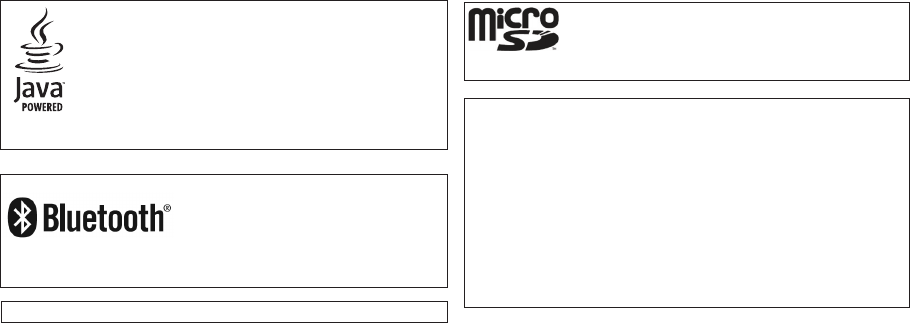
-99-
Java and all Java based trademarks and logos are trademarks or registered
trademarks of Sun Microsystems, Inc. in the U.S. or other countries.
Bluetooth is a trademark of the Bluetooth SIG, Inc.
The Bluetooth word mark and logos are owned by the Bluetooth SIG, Inc. and any
use of such marks by Sharp is under license. Other trademarks and trade names are
those of their respective owners.
MPEG Layer-3 audio coding technology licensed from Fraunhofer IIS and Thomson.
microSD™ is a trademark of the SD Card Association.
Copyright (c) 1985, 1986, 1988, 1992, 1993, 1999 The Regents of the University of
California.
Redistribution and use in source and binary forms, with or without modification, are
permitted provided that the following conditions are met:
1. Redistributions of source code must retain the above copyright notice, this list of
conditions and the following disclaimer.
2. Redistributions in binary form must reproduce the above copyright notice, this list
of conditions and the following disclaimer in the documentation and/or other materi-
als provided with the distribution.
3. Neither the name of the University nor the names of its contributors may be used
to endorse or promote products derived from this software without specific prior
written permission.

-100-
THIS SOFTWARE IS PROVIDED BY THE REGENTS AND CONTRIBUTORS “AS IS’’
AND ANY EXPRESS OR IMPLIED WARRANTIES, INCLUDING, BUT NOT LIMITED
TO, THE IMPLIED WARRANTIES OF MERCHANTABILITY AND FITNESS FOR A PAR-
TICULAR PURPOSE ARE DISCLAIMED. IN NO EVENT SHALL THE REGENTS OR
CONTRIBUTORS BE LIABLE FOR ANY DIRECT, INDIRECT, INCIDENTAL, SPECIAL,
EXEMPLARY, OR CONSEQUENTIAL DAMAGES (INCLUDING, BUT NOT LIMITED
TO, PROCUREMENT OF SUBSTITUTE GOODS OR SERVICES; LOSS OF USE, DATA,
OR PROFITS; OR BUSINESS INTERRUPTION) HOWEVER CAUSED AND ON ANY
THEORY OF LIABILITY, WHETHER IN CONTRACT, STRICT LIABILITY, OR TORT (IN-
CLUDING NEGLIGENCE OR OTHERWISE) ARISING IN ANY WAY OUT OF THE USE
OF THIS SOFTWARE, EVEN IF ADVISED OF THE POSSIBILITY OF SUCH DAMAGE.
Portions of software licensed under the above license include the following ad-
ditional copyright notices and additional conditions.
Copyright (c) 2004 Albert Chin-A-Young. This code is derived from software contrib-
uted to Berkeley by Diomidis Spinellis and James A. Woods, derived from original
work by Spencer Thomas and Joseph Orost.
Copyright (C) 1995, 1997 Wolfgang Solfrank. Copyright (c) 1995 Martin Husemann.
All advertising materials mentioning features or use of this software must display the
following acknowledgement: This product includes software developed by Martin
Husemann and Wolfgang Solfrank.
This code is derived from software contributed to Berkeley by Berkeley Software
Design, Inc.
Copyright(c) UNIX System Laboratories, Inc. All or some portions of this file are
derived from material licensed to the University of California by American Telephone
and Telegraph Co. or Unix System Laboratories, Inc. and are reproduced herein with
the permission of UNIX System Laboratories, Inc.
All advertising materials mentioning features or use of this software must display
the following acknowledgement: This product includes software developed by the
University of California, Berkeley and its contributors.